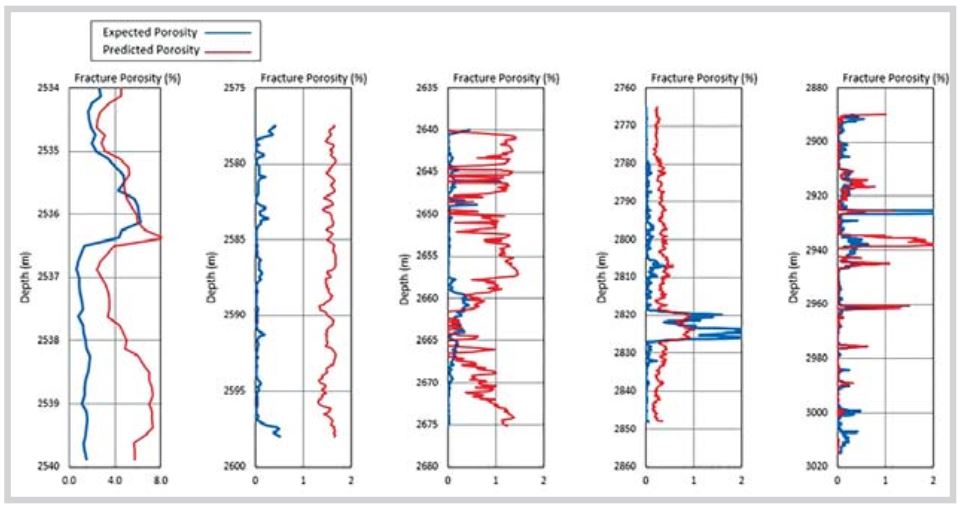Application of deep learning in predicting fracture porosity
Tóm tắt
Deep learning (DL) neural network analysis is the latest development from the Artifi cial Neural Network (ANN) and it is being used more and more in petroleum engineering. In this study, the way to develop a new DL model for well log analysis was attempted and successfully implemented using well log data from a location in the Cuu Long basin, Vietnam. Three sets of analyses were conducted,ie., the first analysis set with a single hidden layer ANN model, the second analysis set with multiple hidden layer ANN model and the third with a DL neural network model. The DL-predicted porosity for a fractured granite basement reservoir of an oil field in the Cuu Long basin was found in the range from 0.0 to 0.082, showing a good match with the conventionally-calculated values. The final deep learning model consists of 5-input layers of gamma ray (GR), deep resistivity (LLD), sonic (DT), density (RHOB) and neutron porosity (NPHI), having 5 hidden neuron layers with 14 neurons per layer. It is worth noting that the transfer function of the rectified linear unit (ReLU), typical for a deep learning analysis, was implemented to replace the common sigmoidal transfer function, ensuring the successful application of DL model. Last but not least, the problem of vanishing gradient specific for a DL neural network model was also explained in details in this paper.
Các tài liệu tham khảo
2. R.C.Chakraboty. Fundamentals of neural network. Artificial Intelligence. 2010.
3. A.Kohli, P.Arora. Application of artificial neural networks for well logs. International Petroleum Technology Conference. 19 - 22 January, 2014.
4. M.Korjani, Andrei Popa, Eli Grijalva, Steve Cassidy, I.Ershaghi. A new approach to reservoir characterization using deep learning neural networks. SPE Western Regional Meeting, Anchorage, Alaska, USA. 23 - 26 May 2016.
5. B.Guler, T.Ertekin, A.S.Grader. An artificial neural network based relative permeability predictor. Journal of Canadian Petroleum Technology. 2003; 42(4).
6. P.H.Giao. Application of ANN in petrophysics. Lecture notes, Asian Institute of Technology, Bangkok, Thailand. 2008.
7. T.Witthayapradit. Formation evaluation using integrated well logging data for a gas field in the Gulf of Thailand. Master thesis, Asian Institute of Technology, Bangkok, Thailand. 2009.
8. N.Nakapraves. Application of ANN analysis in prediction of reservoir porosity for an oil field in the Northern Pattani basin. Master thesis, Asian Institute of Technology, Bangkok, Thailand. 2011.
9. T.Foongthoncharoen. Prediction of permeability and water saturation using neuron networks and fuzzy logics for a clastic reservoir in the Gulf of Thailand. Master thesis, Asian Institute of Technology, Bangkok, Thailand. 2012.
10. C.Sakulluangaram. Petrophysical modelling for the Miocene sand in the South Fang basin. Master thesis, Asian Institute of Technology, Bangkok, Thailand. 2013.
11. D.V.Thanh. Prediction of porosity by ANN analysis integrating well log and seismic attribute data for an oil field in the Cuu Long basin, offshore Vietnam. Professional Master Research Study, Asian Institute of Technology, Bangkok, Thailand. 2013.
12. N.Kano. Soft computing - Based prediction of porosity for a fractured granite basement reservoir. Master thesis, Asian Institute of Technology, Bangkok, Thailand. 2014.
13. T.I.Elkewidy, D.Tiab. An application of conventional well logs to characterize naturally fractured reservoirs with their hydraulic (flow) units; a novel approach. SPE Gas Technology Symposium, Calgary, Canada. 1998.
14. D.Duangngern. Application of Fuzzy Analysis to predict the effective porosity in a clastic reservoir, Pattani basin. Master thesis, Asian Institute of Technology, Bangkok, Thailand. 2015.
15. Y.Wang. ANN-based prediction of fractured rock mass hydraulic conductivity for the Frieda river copper-gold mine in Papua New Guinea. Master thesis, Asian Institute of Technology, Bangkok, Thailand. 2016.
16. R.Kapur. The vanishing gradient problem. A Year of Artificial Intelligence. 2016.

1. Tác giả giao bản quyền bài viết (tác phẩm) cho Tạp chí Dầu khí, bao gồm quyền xuất bản, tái bản, bán và phân phối toàn bộ hoặc một phần tác phẩm trong các ấn bản điện tử và in của Tạp chí Dầu khí.
2. Bằng cách chuyển nhượng bản quyền này cho Tạp chí Dầu khí, việc sao chép, đăng hoặc sử dụng một phần hay toàn bộ tác phẩm nào của Tạp chí Dầu khí trên bất kỳ phương tiện nào phải trích dẫn đầy đủ, phù hợp về hình thức và nội dung như sau: tiêu đề của bài viết, tên tác giả, tên tạp chí, tập, số, năm, chủ sở hữu bản quyền theo quy định, số DOI. Liên kết đến bài viết cuối cùng được công bố trên trang web của Tạp chí Dầu khí được khuyến khích.




